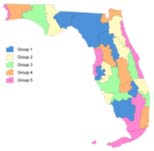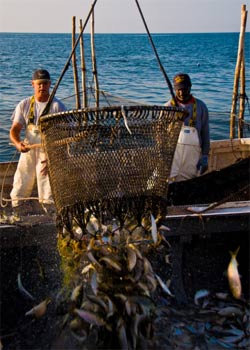Outlining the Bay
Now that you know a little of stream order and finding watershed boundaries, you are ready to find the Chesapeake Bay Watershed. Kind of like hide-and-seek without the hiding part.
As watersheds go, the land area of the Chesapeake Bay is quite large. For example, here is a map of the watersheds in Florida, drawn to the same scale:

There are 130 estuaries in the US – places where salt and fresh water mix – but the Chesapeake Bay is one of the most productive.  Estuaries are incredibly important because the habitat diversity (fresh and salt water) supports a very high biodiversity. In fact the Chesapeake Bay supports about 350 species of fish and 170 species of shellfish.
Estuaries are incredibly important because the habitat diversity (fresh and salt water) supports a very high biodiversity. In fact the Chesapeake Bay supports about 350 species of fish and 170 species of shellfish.
The Bay is also incredibly productive, producing about 100 times as many fish as average ocean. In fact, humans harvest about 100 million pounds of seafood from the Bay every year, plus another nearly 300 million pounds of Menhaden – a small, oily fish used for fertilizer.
Finally, the Chesapeake Bay is shallow – the average depth is only about 21 feet (just a little more than the deep end at your local pool). And the watershed itself is one of the largest in the US, so that means a lot of land is influencing a little bit of water. In fact our very own Chesapeake Bay has a bigger land-to-water ratio than any other bay anyplace in the world, and by a very long shot. The runner up is the Gulf of Finland, which has 7 times more water-per-land than we do.
Copyright University of Maryland, 2007
You may link to this site for educational purposes.
Please do not copy without permission
requests/questions/feedback email: mathbench@umd.edu